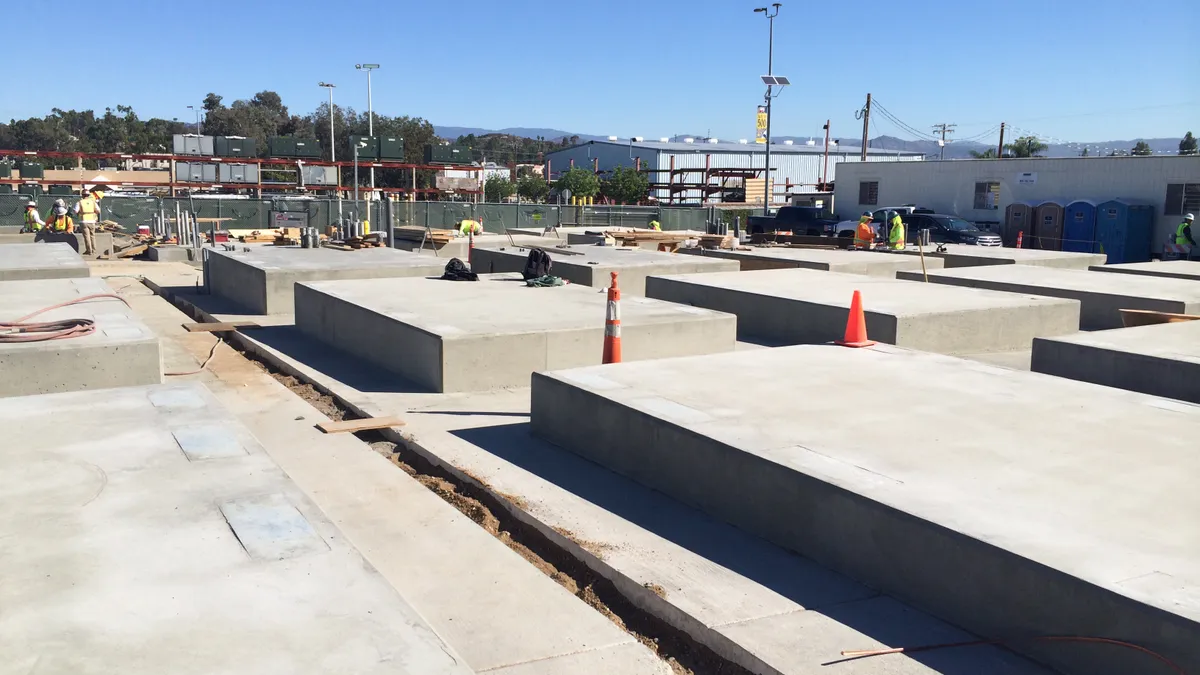Dive Brief:
- The Department of Energy released a draft roadmap Tuesday for its Energy Storage Grand Challenge, first announced in January, which aims to develop and bring to market the next generation of energy storage technologies.
- The program also aims to advance a domestic supply chain for energy storage, something that has gotten increasing attention, analysts say, in the wake of disruptions caused by the COVID-19 pandemic.
- DOE is seeking public input by Aug. 21 to help inform the activities proposed under the draft roadmap.
Dive Insight:
As energy storage plays an increasingly important role in the power sector's transition to cleaner and more distributed resources, DOE wants to make sure the U.S. remains at the forefront of the technology.
"The Energy Storage Grand Challenge leverages the unique, extensive expertise and capabilities of the Department of Energy and our National Labs to really push the envelope when it comes to developing next-generation energy storage," Energy Secretary Dan Brouillette said in a press release.
According to DOE, during Fiscal Years 2017-2019, it has invested over $1.2 billion in energy storage research and development, "establishing an agency-wide, long-term strategy."
The House wants to accelerate such spending and on Monday the Appropriations Committee passed the Fiscal Year 2021 energy and water spending bill, which directs $1.3 billion for energy storage, including $500 million for "energy storage demonstration projects across a portfolio of technologies and approaches" and at least $770.5 million "for the manufacturing of advanced batteries and components."
The focus of the Energy Storage Grand Challenge, DOE said, is "to create and sustain U.S. global leadership in energy storage utilization and exports, with a secure domestic manufacturing base and supply chain that is independent of foreign sources of critical materials." All by 2030.
"The roadmap attempts to paint a comprehensive view of the energy storage landscape, opportunities, and challenges, and presents itself as taking an ecosystem approach, which RMI called for in last year's Breakthrough Batteries report," Rocky Mountain Institute Principal Charlie Bloch told Utility Dive via email, praising DOE's overall effort.
"I appreciate that it does so with an eye toward being storage technology agnostic, as a key threat in the fast-moving space is that policies or regulations are drafted in such a way so as to lock-in Li-ion as the predominant technology when so many other options are still being explored and developed." he continued.
"On the other hand, a key issue somewhat sidestepped by the roadmap is the fact that in order to develop a robust domestic market for innovation and manufacturing, the U.S. must also provide policy and regulatory demand-support signals ... As written, the roadmap seems to strike more of a precautionary tone as it relates to policy, despite acknowledging the requirement for local demand," he added.
"If the U.S. aims to be the type of energy storage player envisioned by the ESGC roadmap, we need to start incentivizing the deployment of these technologies in both stationary and mobile applications."
To help drive U.S. leadership in the next generation of storage technology, the draft roadmap outlines proposed activities across each of the challenge's five tracks: technology development, manufacturing and supply chain, technology transition, policy and valuation, and workforce development.
According to DOE, the technology transition track will "work to ensure that DOE’s R&D transitions to domestic markets through field validation, public private partnerships, bankable business model development, and the dissemination of high quality market data."
The policy track "will provide data, tools, and analysis to support policy decisions and maximize the value of energy storage."
Methodologies for determining the value of battery storage are advancing, but remain complex.
The draft roadmap focuses on challenges related to innovation, manufacturing and deployment for each of the five tracks. It will address how DOE can enable the U.S. to lead in storage research and development, lower the cost and energy impact of manufacturing, strengthen domestic supply chains and work with stakeholders.
The roadmap also includes six use cases related to broad energy or infrastructure goals for communities, businesses and regions, including serving remote communities, critical services and electrified mobility.
"These broad specifications will help identify new and augmented research and development paths for a portfolio of energy storage and flexibility technologies that meet emerging needs," DOE said.
Storage industry sources did not respond to requests for comment by press time.
Update: This article has been updated with new comments from RMI Principal Charlie Bloch.















